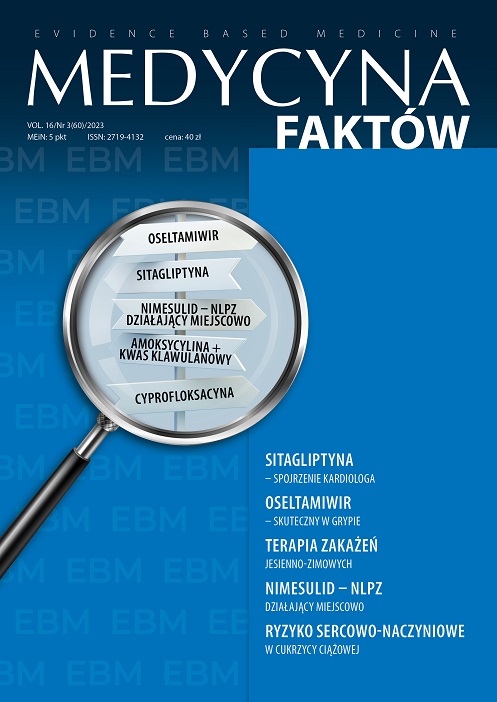Osiem twarzy ramiprilu, czyli drogowskaz terapeutyczny dla lekarza praktyka A.D. 2023 Artykuł przeglądowy
##plugins.themes.bootstrap3.article.main##
Abstrakt
Zgodnie z aktualnymi wytycznymi przy podejmowaniu decyzji o rozpoczęciu leczenia hipotensyjnego najistotniejsze jest oszacowanie ryzyka sercowo-naczyniowego związanego ze stopniem nadciśnienia tętniczego oraz z liczbą i rodzajem współistniejących czynników ryzyka. Współczesna terapia polega bowiem nie tylko na uzyskaniu trwałej normotensji przy zachowaniu dobrej jakości życia, ale również na korygowaniu zaburzeń hemodynamicznych i metabolicznych, a przede wszystkim – na przedłużaniu życia poprzez redukcję zachorowalności i umieralności z powodu incydentów wieńcowych, niewydolności serca oraz udarów mózgu. U większości pacjentów z nadciśnieniem tętniczym i różnymi schorzeniami współistniejącymi lub wysokim ryzykiem powikłań sercowo-naczyniowych najkorzystniejszym wyborem jest lek blokujący układ renina–angiotensyna–aldosteron. W chorobie wieńcowej i innych sytuacjach wysokiego ryzyka krążeniowego szczególna rola przypada ramiprilowi, który oprócz działania hipotensyjnego wykazuje wybitne właściwości kardio- i wazoprotekcyjne.
##plugins.themes.bootstrap3.article.details##
Copyright © by Medical Education. All rights reserved.
Bibliografia
2. Tykarski A, Filipiak KJ, Januszewicz A et al. Zasady postępowania w nadciśnieniu tętniczym – 2019 rok. Wytyczne Polskiego Towarzystwa Nadciśnienia Tętniczego. Nadciśnienie Tętnicze w Praktyce. 2019; 5(1): 1-84.
3. The Heart Outcome Prevention Evaluation Study Investigators. Effect of angiotensin-converting enzyme, ramipril on cardiovascular events in high-risk patients. N Engl J Med. 2000; 342: 145-53.
4. HOPE/HOPE-TOO Study Investigators. Long-term effects of ramipril on cardiovascular events and on diabetes: results of the HOPE study extension. Circulation. 2005; 112(9): 1339-46.
5. Heart Outcomes Prevention Evaluation Study Investigators. Effect of ramipril on cardiovascular and microvascular outcomes in people with diabetes mellitus: results of the HOPE study and MICRO-HOPE substudy. Lancet. 2000; 355: 253-9.
6. The DREAM Trial Investigators. Effect of ramipril on the incidence of diabetes. N Engl J Med. 2006; 355: 1551-62.
7. The Acute Infarction Ramipril Efficacy (AIRE) Study Investigators. Effect of ramipril on mortality and morbidity of survivors of acute myocardial infarction with clinical evidence of heart failure. Lancet. 1993; 342: 821-8.
8. Hall AS, Murray GD, Ball SG on behalf of the AIREX Study Investigators. Follow-up study of patients randomly allocated ramipril or placebo for heart failure after acute myocardial infarction: AIRE Extension (AIREX) Study. Lancet. 1997; 349: 1493-7.
9. Pfeffer MA, Greaves SC, Arnold JM et al. Early versus delayed angiotensin-converting enzyme inhibition therapy in acute myocardial infarction. The healing and early afterload reducing therapy trial. Circulation. 1997; 95(12): 2643-51.
10. Kjoller-Hansen L, Steffensen R, Grande P. The Angiotensin-converting Enzyme Inhibition Post Revascularization Study (APRES). J Am Coll Cardiol. 2000; 35(4): 881-8.
11. Lièvre M, Guéret P, Gayet C et al. Ramipril-induced regression of left ventricular hypertrophy in treated hypertensive individuals. HYCAR Study Group. Hypertension. 1995; 25(1): 92-7.
12. Agabiti-Rosei E, Ambrosioni E, Dal Palu C et al. ACE inhibitor ramipril is more effective than the beta-blocker atenolol in reducing left ventricular mass in hypertension. Results of the RACE (Ramipril Cardioprotective Evaluation) study on behalf of the RACE study group. J Hypertens. 1995; 13: 1325-34.
13. Lonn E, Yusuf S, Dzavik V et al.; SECURE Investigators. Effects of ramipril and vitamin E on atherosclerosis: the study to evaluate carotid ultrasound changes in patients treated with ramipril and vitamin E (SECURE). Circulation. 2001; 103(7): 919-25.
14. Ruggenenti P, Perna A, Gherardi G et al. Renoprotective properties of ACE-inhibition in non-diabetic nephropathies with non-nephrotic proteinuria. Lancet. 1999; 354: 359-64.
15. Charakterystyka produktu leczniczego Tritace, 2,5 mg, 5 mg, 10 mg, tabletki; 06.2021.
16. The ONTARGET Investigators: Yusuf S, Teo KK, Pogue J et al. Telmisartan, ramipril, or both in patients at high risk for vascular events. N Engl J Med. 2008; 358: 1547-59.
17. Szczepańska-Sadowska E, Cudnoch-Jędrzejewska A. Fizjologia i patofizjologia układu renina–angiotensyna. In: Januszewicz A, Januszewicz W, Rużyłło W (ed). Inhibitory konwertazy angiotensyny w leczeniu chorób układu sercowo-naczyniowego. Medycyna Praktyczna, Kraków 2005: 23-62.
18. Enseleit F, Lüscher TF, Ruschitzka F. Angiotensin-converting enzyme inhibition and endothelial dysfunction: focus on ramipril. Eur Heart J. 2003 (suppl A); 5: A31-A36.
19. Fox KM; EURopean trial On reduction of cardiac events with Perindopril in stable coronary Artery disease Investigators. Efficacy of perindopril in reduction of cardiovascular events among patients with stable coronary artery disease: randomised, double-blind, placebo-controlled, multicentre trial (the EUROPA study). Lancet. 2003; 362(9386): 782-8.
20. Borghi C, Ambrosioni E, Novo S et al. Comparison between zofenopril and ramipril in combination with acetylsalicylic acid in patients with left ventricular systolic dysfunction after acute myocardial infarction: results of a randomized, double-blind, parallel group, multicenter, European study (SMILE-4). Clin Cardiol. 2012; 35: 416-23.
21. Braunwald E, Domanski MJ, Fowler SE et al.; PEACE Trial Investigators: Angiotensin-converting-enzyme inhibition in stable coronary artery disease. N Engl J Med. 2004; 351(20): 2058-68.
22. Rouleau JL, Warnica WJ, Baillot R et al.; IMAGINE (Ischemia Management with Accupril post-bypass Graft via Inhibition of the coNverting Enzyme) Investigators: Effects of angiotensin-converting enzyme inhibition in low-risk patients early after coronary artery bypass surgery. Circulation. 2008; 117(1): 24-31.
23. Wienbergen H, Schiele R, Gitt AK et al.; MITRA PLUS Study Group: Impact of ramipril versus other angiotensin-converting enzyme inhibitors on outcome of unselected patients with ST-elevation acute myocardial infarction. Am J Cardiol. 2002; 90(10): 1045-9.
24. Mathew J, Sleight P, Lonn E et al.; Heart Outcomes Prevention Evaluation (HOPE) Investigators: Reduction of cardiovascular risk by regression of electrocardiographic markers of left ventricular hypertrophy by the angiotensin-converting enzyme inhibitor ramipril. Circulation. 2001; 104(14): 1615-21.
25. Cleland JG, Erhardt L, Murray G et al. Effect of ramipril on morbidity and mode of death among survivors of acute myocardial infarction with clinical evidence of heart failure. A report from the AIRE Study Investigators. Eur Heart J. 1997; 18(1): 41-51.
